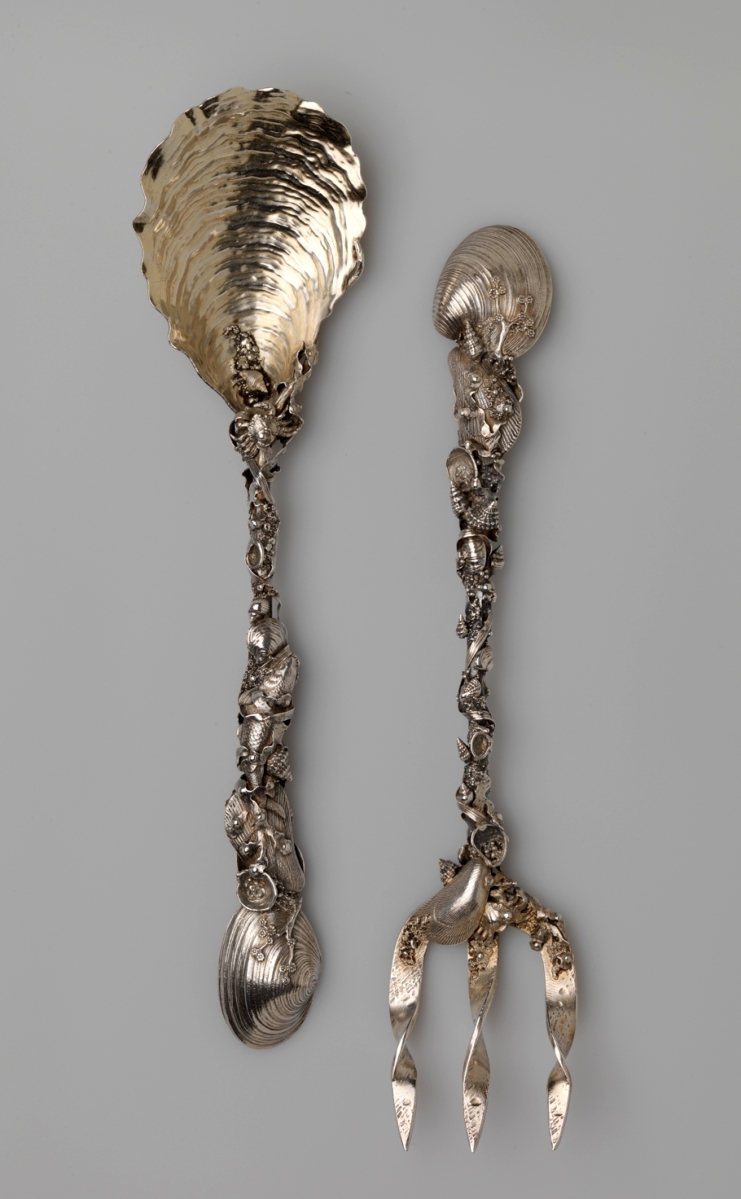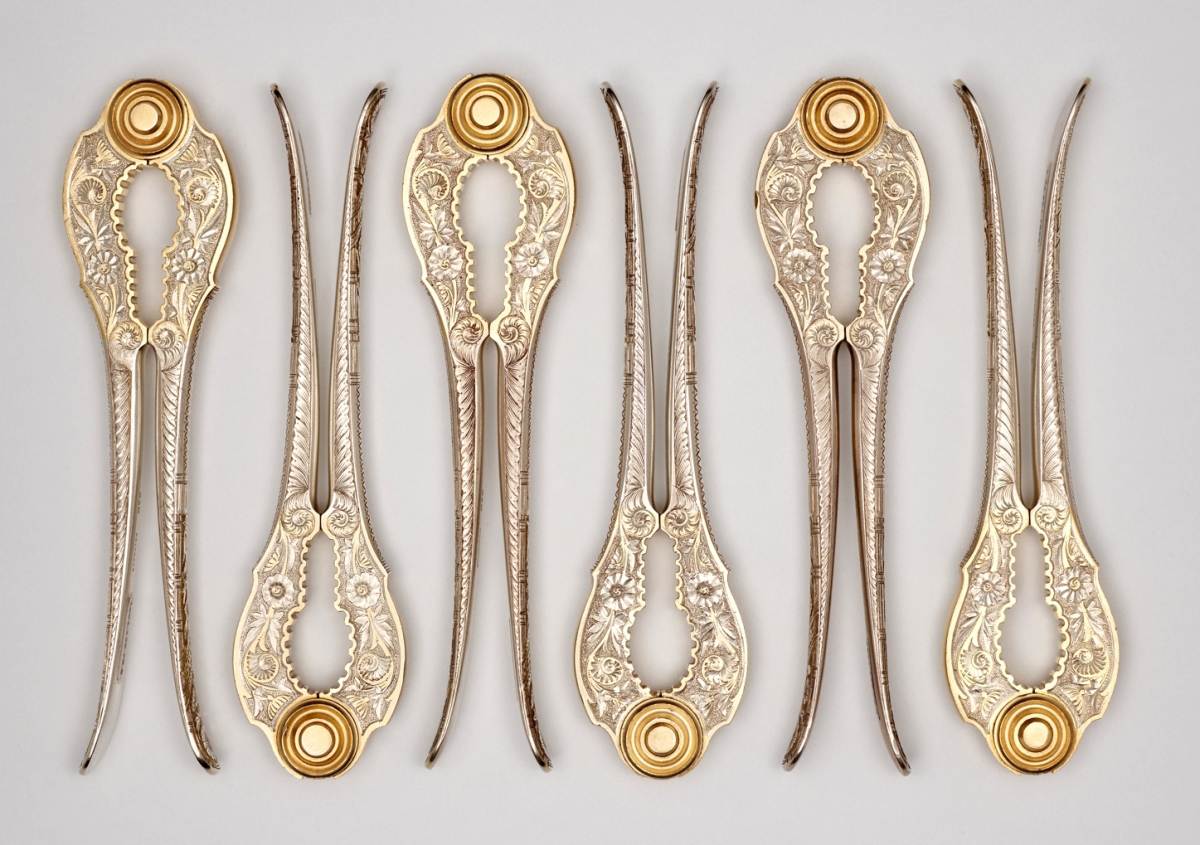
Waste bowl, 1886. Silver with gilding, 3¼ by 5-5/16 by 5-5/16 inches. Rhode Island School of Design Museum.
By Laura Beach
PROVIDENCE, R.I. – Just under a foot tall and flecked with copper and brass, a japanesque silver vase of 1879 set Elizabeth A. Williams on a years-long quest to uncover the all-but-forgotten history of Gorham, the former Rhode Island powerhouse that was once the world’s largest silver manufacturer but today exists in name only.
“It happened long ago and this is the vase that did it,” says Williams, the David and Peggy Rockefeller curator of decorative art and design at the Rhode Island School of Design (RISD) Museum, recalling her first encounter with the vessel at Kansas City’s Nelson-Atkins Museum of Art, where she began her curatorial career.
For Williams, it was not simply that the shimmering vessel was beautiful, or that its decoration, which includes imagery derived from Katsushika Hokusai’s (1760-1849) Manga, was fascinating. Of added interest to this art historian was the manufacturer’s technical ingenuity, deployed in the service of artistic genius. Gorham invented an industrial process to simulate Japanese mokume-gane, an innovation that allowed the firm to introduce its luxurious but short-lived Curio line to the public in 1879. As Williams writes, “The company’s approach was to design and create some of the most exceptional works ever made in silver, and then develop the most effective and inventive technologies and techniques to produce them.”
Williams’ sustained interest in Gorham Manufacturing Company and RISD’s unparalleled collection – the museum owns more than 2,300 pieces of Gorham silver and nearly 2,600 design drawings – are joined in “Gorham: Designing Brilliance, 1850-1970,” the groundbreaking exhibition on view May 3-December 1 in Providence. Charting the company’s rise from a small shop founded on Providence’s Steeple Street in 1831 by Jabez Gorham (1792-1869) to a manufacturer of global renown, the show arrays 600 silver and mixed-metal objects, plus design drawings and tools. The museum supplemented its own holdings with loans from 15 institutions and private collectors.
The curator drew heavily on 6,200 linear feet of Gorham Manufacturing Company archival material, housed in Brown University’s John Hay Library. The company’s library of well-thumbed design references, including seven volumes of Hokusai’s 15-volume Manga and a single book of pressed seaweed specimens, survive at RISD’s Fleet Library. The references provide explicit, contemporaneous insight into the cultural influences that shaped Gorham’s artists and craftsmen, who sometimes borrowed motifs directly from these sources. Through funding provided by the Rhode Island Council for the Humanities, RISD Museum solicited recollections of the firm from the wider community, including former Gorham employees and their descendants.
“We wanted to reach beyond the end product itself, the silver, to also focus on the people, including the artist-maker community, that made Gorham what it was within the contexts of social history, design history, industrial history, manufacturing and advertising,” says Williams, who organized book and exhibition into five sections to tell the story of the firm, a national exemplar. “Gorham was a company that came together with others to build America in the Nineteenth Century.” Of John Gorham (1820-1898), the founder’s son, whose drive to modernize and expand transformed the company, the curator says, “if he were alive today, he’d be doing a GoFundMe project or something like that. He was an entrepreneur.”
Installed in two galleries and encompassing 6,000 square feet, the exhibition begins in 1850, about the time Gorham began making complex hollowware vessels. At the center of the display is the Furber Pavilion, built by RISD Museum to resemble the company’s stand at the 1904 World’s Fair in Saint Louis, known as the Louisiana Purchase Exposition. The Furber Pavilion houses, among other objects, is one of the most extravagant services ever made. Created by Gorham between 1866 and 1880 for Henry Jewett Furber and his wife, Elvira, the 816-piece service for 24 diners is a gilded silver fantasia of Greek, Roman, Italian, Egyptian, English, French, American, Russian and Japanese design elements. Gorham reacquired its single largest commission for its corporate collection in 1949.
Gorham may have been at its boldest and most creative during the Aesthetic Movement of the 1870s and 1880s, when it fashioned an 1881 elephant fruit stand with brocaded surface that is a highlight of the show. But it is for its Martelé line, considered “one of the greatest expressions of the Art Nouveau style in the United States,” that Gorham was and remains best known. Introduced by design director William Christmas Codman (1839-1921), Martelé, characterized by its liquid silhouettes and mastery of the medium, made its formal debut at the 1900 Exposition Universelle in Paris. Now in the collection of the Dallas Museum of Art and on view here, an 1899 silver dressing table and stool was a highlight of Gorham’s Paris display. RISD Museum is showing it alongside its own slightly later Martelé writing table and chair, Gorham’s showpiece for the Louisiana Purchase Exposition.
“RISD Museum is associated with a design school. Making things is what we are all about,” notes the curator, who explores six basic silver-making processes and shows associated tools, some of them made and used by Gorham workers. Playing above “The Gorham Workbench,” as the artist-maker exhibit is called, is a multi-screen video featuring present-day metalsmiths engaged in the six processes: raising, spinning, repoussé and chasing, engraving, stamping and casting. The video incorporates footage from two historical films – The Master Craftsmen, made by the Gorham Manufacturing Company in 1926, and Silver: Heirlooms of Tomorrow, made about Gorham by the US Bureau of Mines in 1930 – as well as clips featuring an 1888 Gorham machine in operation. RISD’s video team traveled to Virginia to record the process after Peter DiCristofaro, creator of the Providence Jewelry Museum, brought the existence of the machine to RISD Museum’s attention.

RISD Museum curator Elizabeth A. Williams organized the groundbreaking show “Gorham Silver: Designing Brilliance, 1850–1970” and edited its accompanying catalog. She charted the exhibition — which features 600 examples of Gorham silver, plus design drawings, casting patterns and tools — on the foam core panels covering one wall of her office.
The research team’s work was aided by the rediscovery of 12,000 pounds of bronze casting patterns that few knew existed. Williams elaborates, “We have access to Gorham’s original ledgers and 600 to 700 drawers of casting patterns. They are out of their framework now and in questionable sequence, but it is remarkable that, 100 years after the ledgers were written, some parts are still in their original drawers. For instance, the ledgers led us to a drawer containing the casting pattern for the antlers on the caribou-head handles of an ice bowl from the Furber service.” For “The Gorham Workbench,” a RISD jewelry and metalsmithing alumna cast a pair of the antlers in silver to illustrate the process.
“Finding the parts was the link to understanding how the objects came together,” says the curator, who consulted Burr Sebring, Gorham’s director of design between 1973 and 1983, and Jeffrey Herman, a Gorham employee between 1981 and 1983. “I sat with them and we looked at a dozen objects. It was eye-opening for me to see how these complicated pieces were made, to understand how many processes and parts were involved in a single piece of silver.” She also welcomed the insights of Arthur Hash, a faculty member in RISD’s jewelry and metalsmithing department, and his students. “It’s enjoyable and edifying to watch their response as makers,” she says.
The design drawings also yielded important discoveries. Williams recalls, “While spending time at the John Hay Library we came across the only extant drawing of a piece – a pair of fruit stands – from the Furber Service. We can’t know what the Gorham designers were thinking, but these drawings really are a visual progression of the design process.”
Supervised by objects conservator Ingrid A. Neuman, a team of 80 trained volunteers spent nearly three years preparing the silver for exhibition. From Brown University archeaology students to RISD faculty and alumni, the tight-knit Providence community pitched in. All were part of an extraordinary, one-of-a-kind project, masterfully realized by RISD Museum, to document the exceptional fusion of art and industry that built one of America’s most successful manufacturing companies.
Published by Rizzoli, Gorham: Designing Brilliance, 1850-1970 builds on pioneering scholarship by Charles H. Carpenter, Samuel J. Hough, Charles Venable and others. It features archival and documentary images, some by Erik Gould, who also photographed the objects in exquisite detail. The book’s authors include Williams, Emily Banas, David L. Barquist, Gerald M. Carbone, Amy Miller Dehan, Jeannine Falino, Catherine L. Futter, Ingrid A. Neuman, John W. Smith and Holly Snyder.
Symposium
In conjunction with the exhibition, a symposium is planned at the museum on May 3 from 10 am to 5:30 pm. Talks by project contributors Barquist, Carbone, Dehan, Falino, Snyder and Williams will explore Gorham’s history and impact on industry, innovation, technology and artistry. Silversmiths involved in Gorham’s recent history will use historical examples on view to lead explorations of processes and techniques. The program is free but registration is required. The public is invited to the exhibition opening between 5:30 and 7:30 pm after the symposium.
Following its close in Providence on December 1, “Gorham Silver: Designing Brilliance, 1850-1970” travels to the Cincinnati Art Museum from March 13 to June 7, 2020, and to the Mint Museum in North Carolina from July 25 to November 1, 2020.
The Rhode Island School of Design Museum is at 20 North Main Street. For information, www.risdmuseum.org or 401-454-6500.






















